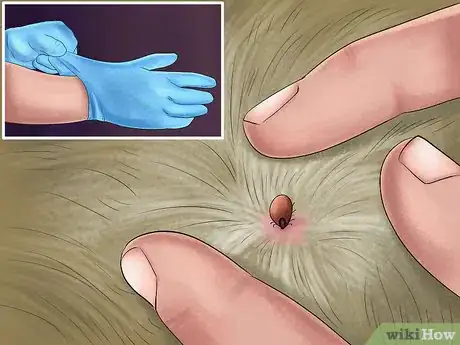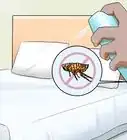This article was co-authored by Melissa Nelson, DVM, PhD. Dr. Nelson is a Veterinarian who specializes in Companion and Large Animal Medicine in Minnesota, where she has over 18 years of experience as a veterinarian in a rural clinic. She received her Doctor of Veterinary Medicine from the University of Minnesota in 1998.
This article has been viewed 38,428 times.
Ticks are a type of parasitic arthropod that feed on the blood of warm-blooded animals. Ticks can cause health problems for cats, so prevention is important. Use topical products and tick collars to protect your cat's fur and skin from ticks. Make sure to maintain a clean environment to keep ticks out of your home. If you do find a tick on your cat, remove it promptly with tweezers and make an appointment with your vet.
Steps
Protecting Your Cat's Fur and Skin
-
1Talk to your vet about medications to prevent ticks. Preventative medications that target both ticks and fleas are important, especially if you have an outdoor cat. Talk to your vet about what types of preventative medications are safe for your cat. Most medications can be purchased at drug stores or pet stores.[1]
- Medications to prevent fleas and ticks are usually applied topically. They seep into the cat's skin and repel both fleas and ticks.[2]
- Make sure you use a medication specifically made for cats. It is dangerous to use a medication made for dogs on a cat.
- Your vet can prescribe topical medication or oral medications.
-
2Comb your cat regularly. Regularly combing with a tick comb can help remove fleas and ticks. A tick comb is a special comb that must be purchased from a vet or pet store as it contains chemicals to kill ticks. It can also help you spot ticks so you can remove them promptly. Strive to brush your cat's fur a few times a week to prevent ticks.[3]
- Dabbing some petroleum jelly on your brush can help remove ticks, as they'll stick to the brush.
- If you notice any ticks in your brush, shake them into a container of warm and soapy water and then flush them down the toilet.
Advertisement -
3Use a tick collar. Tick collars help prevent fleas and ticks by repelling them. Ask your veterinarian about a tick collar for your cat. Opt for a breakaway collar, which will detach quickly to prevent choking if the collar becomes entangled in something.[4] .
- Due to hazards like tree branches, it may not be a good idea to get a collar for an outdoor cat.
-
4Try medicated shampoo. You can find commercially-available pet shampoo containing chemicals that kill ticks. You will need to bathe your cat using the shampoo every two weeks in order for the chemicals to remain effective on your cat's fur.
- This option might not work for you if your cat does not take well to baths.[5]
-
5Use a tick powder. Look for a powder that treats both fleas and ticks that is also formulated for cats. Apply a light sprinkling of the powder onto your cat's fur and rub it in, avoiding the face and eyes. Reapply the powder weekly to maintain its effectiveness.[6]
- Don't use a powder formulated for dogs on cats.
Dealing with Environmental Hazards
-
1Care for your backyard to prevent ticks. If you have a backyard, this area can harbor ticks and fleas that may get into your home. To prevent this, mow your lawn regularly and remove tall weeds. This will give ticks less places to hide.[7]
- You should also keep your outdoor trash cans covered if you have them. This will attract less rodents, which can carry ticks into your yard.
-
2Vacuum regularly. Regular vacuuming can help remove ticks hiding in your carpet. Make a point of vacuuming at least once a week, especially if you live in a rural area where ticks are likely to be dragged in from outdoors.[8]
-
3Restrict your cat's access to tick habitats. If you let your cat go outside, monitor it at all times. Restrict its access to heavily wooded areas, as these places are likely to harbor ticks. It's a good idea to keep your cat in the backyard if you let it go outside. In general, do not let your cat go outside without supervision.[9]
-
4Keep your cat indoors. Rural areas are very prone to ticks.[10] The best prevention is restricting your cat's access to ticks as much as possible. It's a good idea to raise your cat as an indoor cat. This greatly reduces the likelihood your cat will contract fleas or ticks.
Dealing with a Tick Infestation
-
1Do prep work for tick removal. If you notice a tick on your cat, you will need to remove it promptly. Before removing the tick, put on a pair of rubber gloves. Place some rubbing alcohol in a sealable jar or container. This way, you can kill the tick and then take it to your veterinarian to have it tested for potential diseases.[11]
- Cats may become nervous when having a tick removed. If possible, ask a friend or family member to assist you in removing a tick.
-
2Remove the tick with tweezers. Use a pair of tweezers to pry the tick off your cat. Grasp the tick as close to your cat's skin as possible and pull upward to remove the tick. Do not twist or jerk the tweezers as you pull. This may cause limbs or a mouth part to be stuck in your cat's skin.[12]
- Do not squeeze the tick to kill it. Instead, place it in the jar of rubbing alcohol. Squeezing the tick could release dangerous fluids.
-
3Disinfect the area. Wash your hands after removing the tick in soap and water. Rub down your tweezers with alcohol. Make sure to remember where the tick was when you removed it as you should monitor this area for infection.[13]
-
4See a vet after removing the tick. Bring the tick and your cat to a vet's office for testing and evaluation. Your vet can help determine whether your cat should be tested for any diseases transmitted via ticks. Continue to monitor the area after seeing a vet and bring your cat in again if you notice signs of an infection like redness or swelling.[14]
Expert Q&A
-
QuestionCan a house cat get ticks?
 Melissa Nelson, DVM, PhDDr. Nelson is a Veterinarian who specializes in Companion and Large Animal Medicine in Minnesota, where she has over 18 years of experience as a veterinarian in a rural clinic. She received her Doctor of Veterinary Medicine from the University of Minnesota in 1998.
Melissa Nelson, DVM, PhDDr. Nelson is a Veterinarian who specializes in Companion and Large Animal Medicine in Minnesota, where she has over 18 years of experience as a veterinarian in a rural clinic. She received her Doctor of Veterinary Medicine from the University of Minnesota in 1998.
Veterinarian Yes, ticks can "ride" into the house on humans (clothing, shoes) or other pets that go outside (on the fur) and crawl onto the house cat.
Yes, ticks can "ride" into the house on humans (clothing, shoes) or other pets that go outside (on the fur) and crawl onto the house cat. -
QuestionHow do you get a tick off of a cat?
 Melissa Nelson, DVM, PhDDr. Nelson is a Veterinarian who specializes in Companion and Large Animal Medicine in Minnesota, where she has over 18 years of experience as a veterinarian in a rural clinic. She received her Doctor of Veterinary Medicine from the University of Minnesota in 1998.
Melissa Nelson, DVM, PhDDr. Nelson is a Veterinarian who specializes in Companion and Large Animal Medicine in Minnesota, where she has over 18 years of experience as a veterinarian in a rural clinic. She received her Doctor of Veterinary Medicine from the University of Minnesota in 1998.
Veterinarian Use tweezers to grasp the tick as close to its mouthparts as possible and gently pull the ticks from the cat's body. Discard of the tick in a small bit of rubbing alcohol to kill it. Make sure to wash your hands well after doing this.
Use tweezers to grasp the tick as close to its mouthparts as possible and gently pull the ticks from the cat's body. Discard of the tick in a small bit of rubbing alcohol to kill it. Make sure to wash your hands well after doing this. -
QuestionHow can you get rid of ticks on cats?
 Melissa Nelson, DVM, PhDDr. Nelson is a Veterinarian who specializes in Companion and Large Animal Medicine in Minnesota, where she has over 18 years of experience as a veterinarian in a rural clinic. She received her Doctor of Veterinary Medicine from the University of Minnesota in 1998.
Melissa Nelson, DVM, PhDDr. Nelson is a Veterinarian who specializes in Companion and Large Animal Medicine in Minnesota, where she has over 18 years of experience as a veterinarian in a rural clinic. She received her Doctor of Veterinary Medicine from the University of Minnesota in 1998.
Veterinarian The best way to get rid of ticks on cats is to use a flea and tick product like Frontline, Advantage or Seresto collars.
The best way to get rid of ticks on cats is to use a flea and tick product like Frontline, Advantage or Seresto collars.
Warnings
- Never use flea or tick products on a young cat or kitten without first checking with your veterinarian.⧼thumbs_response⧽
- Pyrethrin is a natural insecticide that is commonly found in products such as flea and tick sprays and powders. For the most part, pyrethrins are safe for animals; however, they are toxic to fish. Care should be taken to avoid spray or powders around areas that contain fish, such as backyard ponds, or even bodies of water in which your pet might swim (even cats).⧼thumbs_response⧽
References
- ↑ https://www.aspca.org/pet-care/general-pet-care/fleas-and-ticks
- ↑ http://www.vetstreet.com/dogs/flea-and-tick-prevention
- ↑ https://www.thehonestkitchen.com/blog/7-ways-to-prevent-fleas-and-ticks/
- ↑ http://www.pethealthnetwork.com/cat-health/cat-checkups-preventive-care/fleas-and-ticks-cats-treatment-and-prevention
- ↑ http://www.petmd.com/cat/parasites/evr_ct_10_ways_to_stop_ticks_from_biting_your_cat
- ↑ http://www.petmd.com/cat/parasites/evr_ct_10_ways_to_stop_ticks_from_biting_your_cat?page=2
- ↑ https://www.aspca.org/pet-care/general-pet-care/fleas-and-ticks
- ↑ https://www.thehonestkitchen.com/blog/7-ways-to-prevent-fleas-and-ticks/
- ↑ http://www.vetstreet.com/dogs/flea-and-tick-prevention
- ↑ http://www.vetstreet.com/dogs/flea-and-tick-prevention
- ↑ https://www.aspca.org/pet-care/general-pet-care/fleas-and-ticks
- ↑ https://www.aspca.org/pet-care/general-pet-care/fleas-and-ticks
- ↑ https://www.aspca.org/pet-care/general-pet-care/fleas-and-ticks
- ↑ https://www.aspca.org/pet-care/general-pet-care/fleas-and-ticks
About This Article
To prevent ticks on cats, start by combing your cat regularly with a tick comb to remove fleas and ticks. For an extra measure of protection, dab some petroleum jelly on the brush, which will make the ticks stick to the brush. You can also use a tick collar to prevent ticks from getting on your cat. A medicated shampoo or a tick powder are effective in killing any ticks that are already on your pet. In addition to tending to your cat, mow your lawn to prevent ticks from hiding in tall grass, and vacuum often to remove any ticks hiding in your carpet. For more tips from our Veterinary reviewer, including how to deal with a tick infestation, keep reading!































































